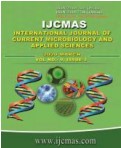


 National Academy of Agricultural Sciences (NAAS)
National Academy of Agricultural Sciences (NAAS)

|
PRINT ISSN : 2319-7692
Online ISSN : 2319-7706 Issues : 12 per year Publisher : Excellent Publishers Email : editorijcmas@gmail.com / submit@ijcmas.com Editor-in-chief: Dr.M.Prakash Index Copernicus ICV 2018: 95.39 NAAS RATING 2020: 5.38 |
Climate change has emerged as a biggest environmental challenge for agricultural production worldwide. In this respect, thermo-tolerance is a major objective in many crop sp. including Brassicas. Due to fluctuation in weather parameters, there is needed to develop temperature tolerant Indian mustard varieties for early sown condition. Keeping the facts in view, the present experiment was made to assess the genetic divergence among thirty-five genotypes from different AICRP-RM research centres under early sown condition. Based on D2 analysis, 35 genotypes were grouped into seven clusters. Cluster II had the highest number of nine genotypes followed by cluster I, III, IV, VI accommodated eight, seven, seven and two genotypes respectively. The maximum inter-cluster distance was observed between cluster V and cluster VII exhibiting high degree of genetic diversity which is utilized through hybridization programme. Intra-cluster values varied from 0.00 (mono-genotype) to maximum 281.34 in cluster IV (comprised of the most heterogeneous genotypes) followed by cluster III. Based on highest inter-cluster distance, mono-genotypic clusters V (DRMR150-35) and VII (TPM-1) followed by VI (KMR10-2 & Pusa Mahak) and VII (TPM-1) were strikingly divergent, indicating greater diversity.Harvest Index (45.01%), seeds/siliqua (22.86%), days to physiological maturity (15.80%) and length of primary mother axis (14.45%) showed maximum contribution towards divergence. Based on contribution towards total divergence, inter-cluster distance and cluster mean performance, clusters VII; V and VI genotypes viz. TPM-1; DRMR-150-35 and KMR10-2, Pusa Mahak were most promising divergent genotypes of Indian mustard and subsequently be utilized in intermating i.e.TPM-1/DRMR-150-35; TPM-1/KMR-10-2 & TPM1/Pusa Mahak for generation of wider variability and could be effectively utilized in hybridization –selection breeding programme to obtain desirable early –sown Indian mustard.
 |
 |
 |
 |
 |